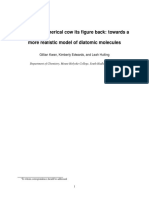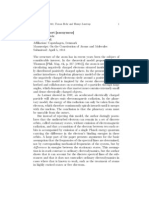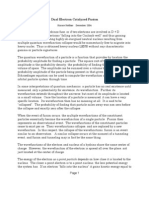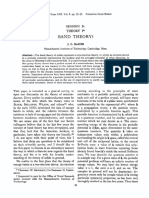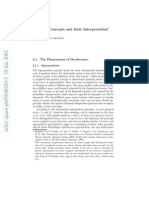The Concept of Resonance: Resonance in Quantum Mechanics
The Concept of Resonance: Resonance in Quantum Mechanics
Uploaded by
mubshrCopyright:
Available Formats
The Concept of Resonance: Resonance in Quantum Mechanics
The Concept of Resonance: Resonance in Quantum Mechanics
Uploaded by
mubshrOriginal Description:
Original Title
Copyright
Available Formats
Share this document
Did you find this document useful?
Is this content inappropriate?
Copyright:
Available Formats
The Concept of Resonance: Resonance in Quantum Mechanics
The Concept of Resonance: Resonance in Quantum Mechanics
Uploaded by
mubshrCopyright:
Available Formats
In the Classroom
The Concept of Resonance
Donald G. Truhlar
Department of Chemistry and Supercomputing Institute, University of Minnesota, Minneapolis, MN 55455-0431;
truhlar@umn.edu
A recent article in this Journal advocates substituting the Resonance in Quantum Mechanics
word “delocalization” for “resonance” (1). This recommen-
dation should not be accepted because modern electronic Probability
structure theory shows that “delocalization” and “resonance” If one wishes to discuss a situation involving resonance
are not the same, nor is one a special case of the other. without using the word “resonance”, the following general lan-
guage is one correct way to do so. In quantum mechanics, an
Examples of Delocalization and Resonance approximate description of the ground state of a system cor-
responds to a higher energy than the true energy. A quantum
In electronic structure theory, we must include electronic mechanical wave function is a probability amplitude. For ex-
spin in order to satisfy the Pauli principle. I will neglect spin– ample, an electron in a hydrogen atom has a nonzero prob-
orbit coupling to make the arguments simpler. Then a suit- ability to be near the nucleus and a nonzero probability to be
able electronic wave function for an atomic or molecular far from it. Restricting the ground-state wave function so that
system with N electrons must be antisymmetric under per- any situation with a nonzero probability is excluded would
mutation (transposition) of two electrons and must corre- correspond to a higher energy than the true ground-state en-
spond to a definite value S of total electronic spin. If the ergy and would be a more approximate description.
spatial part of the electronic wave function is formed from Similarly in the H2 molecule there is a nonzero prob-
no more than N orbitals, each of which may be interpreted ability of observing a charge distribution that corresponds to
as the variationally best representation of an electron mov- our usual picture of a covalent bond. There are also nonzero
ing in the average field of the other electrons, then the elec- probability amplitudes for observing structures that could be
tronic wave function including spin must be expressible as a described as H+H− or H−H+ (these zwitterionic structures are
permutation operator acting on product of N spatial orbitals usually called “ionic” in valence bond theory.) Restricting the
times a spin function (2); this kind of approximate wave func- wave function to exclude any of these contributions would
tion is called a spin-coupling-optimized generalized valence correspond to a higher energy than the true ground state and
bond wave function. In such a wave function, the orbitals to a less accurate description.
do not need to transform according to the full symmetry of Sometimes one starts with the model wave function cor-
the molecule (2). Thus, for example, the orbitals can be lo- responding to the restricted wave function with just the co-
calized even in symmetric systems (3). valent component. Then one proceeds to write a more
By restricting the form of the wave function, one can accurate wave function that also includes the ionic contribu-
obtain, as a special case, the Hartree–Fock molecular orbital tions. The covalent and ionic contributions are sometimes
method in which the wave function may be written as a Slater called covalent and ionic configurations (or valence bond
determinant of delocalized symmetry orbitals. In contrast, structures), and this process of adding the ionic contribu-
requiring the orbitals of the more general spin-coupling-op- tions is sometimes called configuration mixing or configura-
timized wave function to be delocalized symmetry functions tion interaction. But the students need to be able to read the
would be a constraint that raises the energy and—by the literature so one should add: this process is also called reso-
variational principle—makes the wave function less accurate. nance stabilization, and the energy lowering in proceeding
This provides a very general example of where a delocalized from the energy corresponding to the restricted wave func-
description of a system is associated with a higher energy than tion to the more accurate energy is called resonance energy.
the localized one; thus it is wrong to consider delocalization Learning any scientific field includes not only learning
as equivalent to resonance stabilization. Alternative but the concepts of the field but also learning the language that
equivalent explanations of delocalization are provided by is used by specialists in that field. This is required in order to
other authors (4, 5). understand lectures, to communicate with colleagues, and to
One can consider another example, namely HCl. This read the literature. “Resonance” is an important and well es-
may be considered a resonance hybrid of a covalent and an tablished technical term in chemistry. Students should learn
ionic structure (6).1 In HCl, the covalent structure has a weight it. Even if it were possible to legislate it away (which seems
larger than 50%, and the ionic structure, therefore, has a impossible after 75 years of use), it would be wrong to re-
weight less than 50%. Resonance stabilization of the domi- place it by “delocalization” since that is a different concept.
nant covalent structure by the ionic structure leads to the va-
lence electrons being more localized on the chlorine and less Wave Functions
delocalized over two centers than in the covalent structure. Reference 1 also asks “What is resonating?” and concludes
These two examples show that delocalization is not the that “there is no oscillation of any kind.” One can give an-
same concept as resonance. other answer to this question, but it requires a more advanced
www.JCE.DivCHED.org • Vol. 84 No. 5 May 2007 • Journal of Chemical Education 781
In the Classroom
understanding of quantum mechanics than the material dis- state electronic energy when one improves a quantum me-
cussed above. When one discusses molecular structure and chanical model containing a single valence bond structure
energetics one is usually referring to the structure correspond- in the wave function to include other significant valence bond
ing to the ground electronic state (7). Kerber’s article (1) makes structures, where “structure” is defined in Note 1. It is in-
the important point that historically Pauling often used time- structive to refer to several research publications where the
dependent language to discuss resonance. Since the ground concept of resonance is used correctly in the context of mod-
state is a stationary state, it has a time-independent probabil- ern valence bond theory (5, 11).
ity distribution (8), and therefore time-dependent language is
incorrect. However, all wave functions (that is, all solutions of Note
the time-dependent Schrödinger equation) are not necessarily
stationary states. Superpositions of stationary states correspond- 1. The word “structure” is used here in the valence bond sense
ing to different energies are called wave packets. A valence bond of an electronic configuration state function corresponding to a single
wave function corresponding to a single covalent or ionic struc- set of spin orbitals with a spin coupling corresponding to a particu-
ture is a wave packet, as is a linear combination of two such lar covalent or ionic bonding scheme. A configuration state func-
wave functions ψA and ψB. In principle one could create a la- tion is an antisymmetric many-electron trial function composed
ser pulse that would excite a state corresponding to such a wave (usually) of the minimum number of Slater determinants required
packet. In the absence of decoherence, and if we assume that to obtain the correct spatial and spin symmetry.
ψA and ψB are orthogonal and that ψA is only strongly coupled
to ψB and vice versa, such a wave packet would physically os- Literature Cited
cillate between the two valence bond structures with a fre-
quency ν (in cycles per second) given by 1. Kerber, R. C. J. Chem. Educ. 2006, 83, 223–227.
1 2. Ladner, R. C.; Goddard, W. A., III J. Chem. Phys. 1969, 51,
2 ∆2
2
2 1073–1087.
ν = + ψ A H ψB (1) 3. Wadt, W. R.; Goddard, W. A., III J. Am. Chem. Soc. 1975, 97,
h 4
2034–2047.
where h is Planck’s constant, Ĥ is the Hamiltonian, and 4. (a) Hall, G. G.; Lennard-Jones, J. E. Proc. R. Soc. London, Ser.
A 1950, 202, 155–165. (b) Anderson, W. P.; Burdett, J. K.;
∆ = ψB H ψB − ψ A H ψ A (2) Czech, P. T. J. Am. Chem. Soc. 1994, 116, 8808–8809.
5. Voter, A. F.; Goddard, W. A., III Chem. Phys. 1981, 57, 253–
If the two structures are degenerate, then ∆ is zero, and 259.
this is the frequency mentioned on page 224 of ref 1. In prac- 6. Pauling, L. The Nature of the Chemical Bond, 3rd ed.; Cornell
tice, even if one could devise such a laser pulse, and even if University Press: Ithaca, NY, 1960; pp 67–75.
the assumptions mentioned above were valid, the perfectly 7. Herzberg, G. Molecular Spectra and Molecular Structure. III. Elec-
resonating superposition would not last very long because the tronic Spectra and Electronic Structure of Polyatomic Molecules;
electronic wave function in a nonstationary state is subject von Nostrand Reinhold: New York, 1966; p 9.
to decoherence (which is defined here as the evolution of a 8. Atkins, P. W.; Friedman, R. Molecular Quantum Mechanics,
pure state of the electronic subsystem of the molecular sys- 4th ed.; Oxford University Press: New York, 2005; p 25.
tem to a mixed state; ref 9); even for a molecule isolated in 9. Gottfried, K.; Yan, T.-M. Quantum Mechanics Fundamentals;
space in an ultrahigh vacuum, the motion of the molecule’s 2nd ed.; Springer: New York, 2003; pp 40–50.
own nuclei causes decoherence of the electronic wave func- 10. Zhu, C.; Jasper, A. W.; Truhlar, D. G. J. Chem. Theory Comput.
tion (10). Nevertheless, at least in this idealized case, there 2005, 1, 527–540.
does exist a physical resonating state, although it is not the 11. (a) Voter, A. F.; Goddard, W. A., III J. Chem. Phys. 1981, 75,
same as the ground-state wave function one is usually dis- 3638–3639. (b) Cooper, D. L; Gerratt, J.; Raimondi, M. Topics
cussing in the context of molecular structure and energetics. Current Chem. 1990, 153, 41–55. (c) Paldus, J.; Li, X. Israel
J. Chem. 1991, 31, 351–362. (d) Hiberty, P. C. J. Mol. Struct.
Summary 1998, 451, 237–261. (e) Shaik, S.; Shurki, A. Angew. Chemie
Int. Ed. 1999, 38, 586–625. (f ) Dijstra, F.; van Lenthe, J. H.;
The meaning of resonance energy as it appears in va- Havenith, R. W. A.; Jenneskens, L. W. Int. J. Quantum Chem.
lence bond theory is the lowering of the calculated ground- 2003, 91, 566–574.
782 Journal of Chemical Education • Vol. 84 No. 5 May 2007 • www.JCE.DivCHED.org
You might also like
- Of Electron Interactions. Interactions : Collective Description MagneticDocument10 pagesOf Electron Interactions. Interactions : Collective Description MagneticSandeep BorgaonkarNo ratings yet
- S.A. Kivelson Et Al - 2e or Not 2e: Flux Quantization in The Resonating Valence Bond StateDocument6 pagesS.A. Kivelson Et Al - 2e or Not 2e: Flux Quantization in The Resonating Valence Bond StatePo48HSDNo ratings yet
- Quantum and Classical Statistics of The Electromagnetic Zero-Point FieldDocument19 pagesQuantum and Classical Statistics of The Electromagnetic Zero-Point FieldMilan StepanovNo ratings yet
- Quantum and Classical Statistics of The Electromagnetic Zero-Point FieldDocument19 pagesQuantum and Classical Statistics of The Electromagnetic Zero-Point FieldMilan StepanovNo ratings yet
- Quantum and Classical Statistics of The Electromagnetic Zero-Point FieldDocument19 pagesQuantum and Classical Statistics of The Electromagnetic Zero-Point FieldMilan StepanovNo ratings yet
- The Original Hartree Paper From 1928Document22 pagesThe Original Hartree Paper From 1928Henrique CastroNo ratings yet
- 1966 - Berry - J Chem Educ - V - Atomic OrbitalsDocument17 pages1966 - Berry - J Chem Educ - V - Atomic Orbitalsvitoribeiro90No ratings yet
- Additional Light Waves in Hydrodynamics and Holography: UCSD-PTH-10-05 LPTENS-10/41Document20 pagesAdditional Light Waves in Hydrodynamics and Holography: UCSD-PTH-10-05 LPTENS-10/41lepapNo ratings yet
- Mott Insulators Basic IntroductionDocument36 pagesMott Insulators Basic Introductionnoygalron30No ratings yet
- Electron Correlations in Narrow Energy BandsDocument20 pagesElectron Correlations in Narrow Energy BandsJoy RoyNo ratings yet
- Quantifying The Nature of Lone Pair DomainsDocument13 pagesQuantifying The Nature of Lone Pair Domainsjulian caraxNo ratings yet
- (NDWP1D) Schlagheck Epjd03Document15 pages(NDWP1D) Schlagheck Epjd03John LeónNo ratings yet
- Crystal Momentum - WikipediaDocument4 pagesCrystal Momentum - WikipediaAboubakr AtefNo ratings yet
- Quantum Vacuum Energy ExtractionDocument14 pagesQuantum Vacuum Energy ExtractionAkshaya Kumar RathNo ratings yet
- PolaronDocument7 pagesPolaronTeka KamNo ratings yet
- 4.pdf Boild 4.pdf BoildDocument13 pages4.pdf Boild 4.pdf BoildzzozzoNo ratings yet
- Quantum Hall Effect - WikipediaDocument10 pagesQuantum Hall Effect - WikipediaTahafanMaggedonNo ratings yet
- Module 4Document43 pagesModule 4Dominador RomuloNo ratings yet
- On the quantum theory of radiation and the structure of the atomFrom EverandOn the quantum theory of radiation and the structure of the atomNo ratings yet
- 29 - CHAPTER 3 Intermolecular Forces and Potential Enegy SurfacesDocument9 pages29 - CHAPTER 3 Intermolecular Forces and Potential Enegy SurfacesMohit Kamboj100% (3)
- Lab 3Document45 pagesLab 3Gillian KwanNo ratings yet
- The Pseudopotential PanaceaDocument9 pagesThe Pseudopotential PanaceaMedo MedicNo ratings yet
- 1987.02.20 - COHEN - HPC - Physics of Metal ClustersDocument9 pages1987.02.20 - COHEN - HPC - Physics of Metal ClustersAlejandra AwimbaweNo ratings yet
- Referee ReportDocument6 pagesReferee ReportIngenioeren100% (1)
- Theories of Variable Mass Particles and Low Energy Nuclear PhenomenaDocument29 pagesTheories of Variable Mass Particles and Low Energy Nuclear PhenomenaMark DavidsonNo ratings yet
- Musumeci 2005 653Document10 pagesMusumeci 2005 653Particle Beam Physics LabNo ratings yet
- The Bohr Correspondence Principle: Kepler Orbits of The Electron in A Hydrogen AtomDocument9 pagesThe Bohr Correspondence Principle: Kepler Orbits of The Electron in A Hydrogen AtomIzhar YarNo ratings yet
- Plasma OscillationDocument5 pagesPlasma OscillationMuhammad AkramNo ratings yet
- 2.1 The Many-Body Problem in Quantum MechanicsDocument17 pages2.1 The Many-Body Problem in Quantum MechanicsgudduspeaksNo ratings yet
- Bound Electron Pairs in A Degenerate Fermi GasDocument2 pagesBound Electron Pairs in A Degenerate Fermi GasCharles Marcotte GirardNo ratings yet
- Dual Electron Cat FusionDocument3 pagesDual Electron Cat FusiondarthsideousNo ratings yet
- PhotonDocument13 pagesPhotonjohndoeeulerNo ratings yet
- Theory of The Stability of Lyophobic ColloidsDocument6 pagesTheory of The Stability of Lyophobic Colloidsivan celyNo ratings yet
- Radiation Reaction General Approach and ApplicatioDocument28 pagesRadiation Reaction General Approach and ApplicatioJohan David Miranda CalderaNo ratings yet
- Gravity and The Quantum Vacuum Inertia Hypothesis. I. Formalized Groundwork For Extension To GravityDocument13 pagesGravity and The Quantum Vacuum Inertia Hypothesis. I. Formalized Groundwork For Extension To GravityMilan StepanovNo ratings yet
- Gravity and The Quantum Vacuum Inertia Hypothesis. I. Formalized Groundwork For Extension To GravityDocument13 pagesGravity and The Quantum Vacuum Inertia Hypothesis. I. Formalized Groundwork For Extension To GravityMilan StepanovNo ratings yet
- Zero-Point Fields, Gravitation and New PhysicsDocument21 pagesZero-Point Fields, Gravitation and New PhysicsMrWoodenStickNo ratings yet
- ThesisDocument8 pagesThesisapi-434089240No ratings yet
- 2016 Bookmatter TheQuantumHandshakeDocument48 pages2016 Bookmatter TheQuantumHandshakeAkshay SatputeNo ratings yet
- Anyons and The Quantum Hall Effect - A Pedagogical Review: Ady SternDocument46 pagesAnyons and The Quantum Hall Effect - A Pedagogical Review: Ady Sternstalker2222No ratings yet
- Why Tight-Binding Theory?: Walter A. HarrisonDocument5 pagesWhy Tight-Binding Theory?: Walter A. HarrisonzoehdiismailNo ratings yet
- Hestenes Spin UncertantyDocument34 pagesHestenes Spin UncertantypaulotmuzyNo ratings yet
- Bonding in Molecules 2019 2nd Yr Michaelmas TermDocument71 pagesBonding in Molecules 2019 2nd Yr Michaelmas Termtresa.george27No ratings yet
- Band Theory?: J. Phys. Chem. SolidsDocument5 pagesBand Theory?: J. Phys. Chem. Solidsgarguz94No ratings yet
- Disordered Electronic SystemsDocument51 pagesDisordered Electronic Systemsjoder123456789No ratings yet
- Peng 2023 Commun. Theor. Phys. 75 085102Document12 pagesPeng 2023 Commun. Theor. Phys. 75 085102pyan6110No ratings yet
- J. Weiß Et Al - Saddle-Node Bifurcations in The Spectrum of HOClDocument17 pagesJ. Weiß Et Al - Saddle-Node Bifurcations in The Spectrum of HOClImasmzNo ratings yet
- Origin and Propagation of The ELECTRIC FIELDDocument6 pagesOrigin and Propagation of The ELECTRIC FIELDAKISNo ratings yet
- Theory of Positrons: Physical Eptf. BER 1949Document11 pagesTheory of Positrons: Physical Eptf. BER 1949Myname AnameNo ratings yet
- Dirac 1931Document13 pagesDirac 1931pauloricardo07121969No ratings yet
- Plot Phillips - Van VechtenDocument18 pagesPlot Phillips - Van VechtenDwian SastikaNo ratings yet
- PhysRevLett 132 186303Document8 pagesPhysRevLett 132 186303Himal BhattNo ratings yet
- Roi Baer, Ester Livshits and Daniel Neuhauser - Avoiding Self-Repulsion in Density Functional Description of Biased Molecular JunctionsDocument10 pagesRoi Baer, Ester Livshits and Daniel Neuhauser - Avoiding Self-Repulsion in Density Functional Description of Biased Molecular JunctionsNedsy8No ratings yet
- Ms Dosch Muller SierokaDocument52 pagesMs Dosch Muller SierokaSteven ScottNo ratings yet
- DFT MetaisDocument60 pagesDFT MetaisGiliandroFariasNo ratings yet
- Unit 5 FaqDocument4 pagesUnit 5 FaqQuazi Rafquat HossainNo ratings yet
- Zeh-2002-Decoherence - Basic Concepts and Their Interpretation.9506020v3Document42 pagesZeh-2002-Decoherence - Basic Concepts and Their Interpretation.9506020v3sscript14100% (2)
- Introduction To Photonic Crystals: Bloch's Theorem, Band Diagrams, and Gaps (But No Defects)Document16 pagesIntroduction To Photonic Crystals: Bloch's Theorem, Band Diagrams, and Gaps (But No Defects)Silvio SavoiaNo ratings yet
- What is Charge? – The Redefinition of Atom - Energy to Matter ConversionFrom EverandWhat is Charge? – The Redefinition of Atom - Energy to Matter ConversionNo ratings yet
- Radial Implications of the Unified Field: Classical Solutions for Atoms, Quarks and Other Sub-Atomic ParticlesFrom EverandRadial Implications of the Unified Field: Classical Solutions for Atoms, Quarks and Other Sub-Atomic ParticlesNo ratings yet
- Annealing of Polymer MembranesDocument2 pagesAnnealing of Polymer MembranesAyyaz ButtNo ratings yet
- Physics of High Intensity Laser Plasma InteractionsDocument203 pagesPhysics of High Intensity Laser Plasma InteractionsDu RoyNo ratings yet
- Para Raio 138 KV TE ConectivityDocument16 pagesPara Raio 138 KV TE ConectivityvendafactorNo ratings yet
- Mozley TableDocument6 pagesMozley TableZulqayyim Noor Azizul100% (2)
- Metal and Non M MetalDocument25 pagesMetal and Non M MetalDebasish MohantyNo ratings yet
- 1.1 - Development of The Atomic ModelDocument2 pages1.1 - Development of The Atomic ModelcakedesuNo ratings yet
- Feature & Excellence R407C: 23 % R32 25 % R125 52 % R134ADocument2 pagesFeature & Excellence R407C: 23 % R32 25 % R125 52 % R134ADidi RamadaniNo ratings yet
- Types of FailureDocument11 pagesTypes of FailureRavi PalaskarNo ratings yet
- Thermomechanical Fatigue Experiment and Failure Analysis On ADocument11 pagesThermomechanical Fatigue Experiment and Failure Analysis On Amohammad zalakiNo ratings yet
- Manuel Service Manual ASYG 30 36 KMTADocument32 pagesManuel Service Manual ASYG 30 36 KMTAkarane1488No ratings yet
- Magnetism 3Document18 pagesMagnetism 3VinayKumarNo ratings yet
- Assignment No. 2: Question: Write A Note On Hydration of Cement?Document9 pagesAssignment No. 2: Question: Write A Note On Hydration of Cement?Nageen NaqviNo ratings yet
- Science Sample Paper - 4Document13 pagesScience Sample Paper - 4ShwetaNo ratings yet
- Integration of Seismic and PetrophysicsDocument17 pagesIntegration of Seismic and Petrophysicsdanial bramantaNo ratings yet
- 10 1016@j Renene 2020 11 011Document44 pages10 1016@j Renene 2020 11 011UmairNo ratings yet
- Math Physics Chemstry BiologyDocument8 pagesMath Physics Chemstry BiologyStozerNo ratings yet
- Deburring and HonningDocument23 pagesDeburring and HonningAbhishek Kumar100% (1)
- Cambridge International Examinations Joint Examination For The School Certificate and General Certificate of Education Ordinary LevelDocument8 pagesCambridge International Examinations Joint Examination For The School Certificate and General Certificate of Education Ordinary LevelTan Yong KhaiNo ratings yet
- Anaerobic Processes (Chapter 10) : AdvantagesDocument13 pagesAnaerobic Processes (Chapter 10) : AdvantagesΔημητρηςΣαρακυρουNo ratings yet
- 10 11648 J Am 20170605 16 PDFDocument17 pages10 11648 J Am 20170605 16 PDFAmmr MahmoodNo ratings yet
- Astm A-572Document5 pagesAstm A-572Wanderley CardosoNo ratings yet
- Molecules of LifeDocument14 pagesMolecules of LifeVikas Singh PariharNo ratings yet
- Dhruv Joshi 12B Physics Board ProjectDocument17 pagesDhruv Joshi 12B Physics Board Projectdhruv6279No ratings yet
- Crack Free PHC PDFDocument7 pagesCrack Free PHC PDFVaswati BiswasNo ratings yet
- ENGG CUTOFF 2023 HK R2kannadaDocument45 pagesENGG CUTOFF 2023 HK R2kannadakiran smNo ratings yet
- ME692 - Welding - Lecture Till 6 FebDocument107 pagesME692 - Welding - Lecture Till 6 Febpramrahar20No ratings yet
- Assignment 2 (334421)Document5 pagesAssignment 2 (334421)AB RehmanNo ratings yet
- Design and Construction of Mobile Biochar Kiln ForDocument16 pagesDesign and Construction of Mobile Biochar Kiln ForjkNo ratings yet
- BearingsDocument17 pagesBearingssubodhstudymaterialsNo ratings yet
- Topic List and Sample Items - B. TechDocument14 pagesTopic List and Sample Items - B. TechAryan ThakurNo ratings yet




















